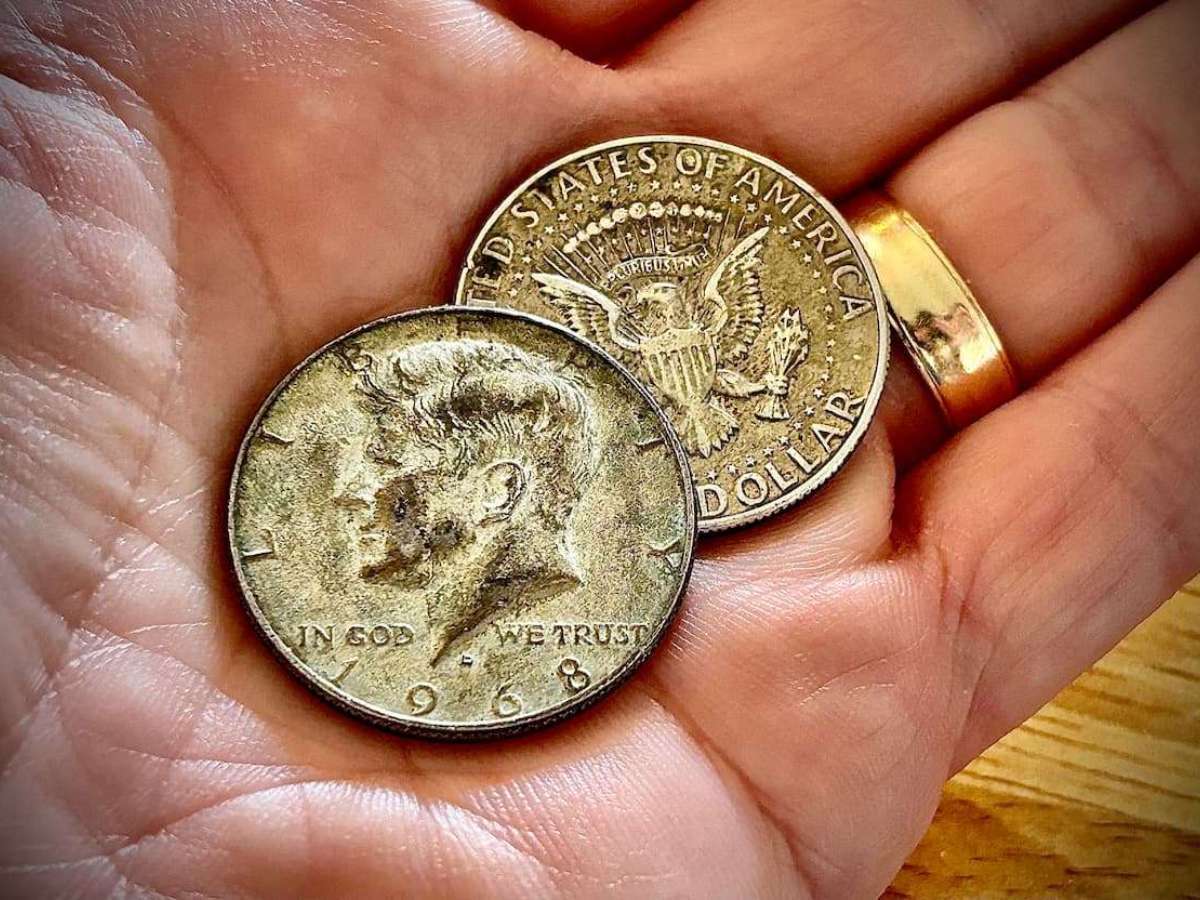A lot of people leaving comments here at The Fun Times Guide to Coins havsilvee been asking me about their silver pennies.
Of course, many of these silver one-cent coins are 1943 pennies, which really aren’t silver pennies — they’re actually made with zinc-coated steel.

However, many of these questions about silver pennies have nothing to do with 1943 Lincoln cents or even the highly rare 1944 steel cent (a mint error caused by leftover steel coin blanks getting accidentally getting stamped with the 1944 coin die).
I’ve had a lot of people ask me about their 1961 silver penny. Or their 1978 silver penny. Or their 1986 silver penny.
Since I’ve been getting so many questions about silver pennies on a regular basis, I’ve decided that it’s time to write a post about them and hopefully help answer some readers’ questions.
Why Do Some Pennies Look Silver?
There are many reasons why a penny could appear silver.
Silver pennies can be caused by:
- An error at the U.S. Mint
- Plating with silver, pewter, or mercury
- A common science experiment
Of course, determining what might have caused your penny to look silver requires digging a little deeper.
Any of the causes listed above could apply to your penny — so to figure out what’s going on, you’ll need the help of a trusty coin scale. (Any scale that measures by the gram, or the fraction of a gram, will work.)
How To Determine If Your Penny Is Silver Due To A Mint Error
I have 4 examples for you.
Most of these U.S. Mint errors have resulted in rare coins that collectors are eager to find!
#1 – The most valuable circumstance for your coin would be if it was struck on the wrong planchet (or coin blank) at the U.S Mint.

Such is the case for 1944 steel cents, as mentioned earlier in this post.
Approximately 35 of the 1944 pennies were struck on the zinc-coated steel planchets used for the iconic 1943 steel cent.
- Steel pennies can stick to a magnet.
- Steel pennies also weigh less than their copper counterparts — 2.70 grams versus 3.11 grams.
Steel cents are worth a lot more:
- A 1944 steel cent can auction for upward of $75,000,
- A typical 1944 copper Lincoln cent is worth around 5 to 10 cents.
#2 – A second reason some pennies look silver is because they were struck on dime planchets at the U.S. Mint.
These types of errors, though not as rare or valuable as the 1944 steel penny, are still highly unusual and sought-after by coin collectors – especially those who prize error coins.
You can tell a penny on dime planchet error relatively easily:
- First, part of the design (likely the rim) would be cut off — because a dime planchet is smaller than a penny planchet.
- Also, the coin would weigh less. Silver dime planchets (made before 1965) weigh 2.5 grams, and copper-nickel clad planchets (made since 1965) weigh 2.27 grams.
If you think you have such a piece, you will want to send it to a third-party coin grading company to have it authenticated — because penny on dime planchet error coins are worth around $300 and up.
#3 – A third U.S. Mint error that has caused some pennies made since the 1980s to appear silver is faulty copper plating.
- In some instances, the copper plating on zinc-based Lincoln cents (produced since 1982) isn’t fully articulated.
- In other cases, the plating is completely missing.
These error pennies are worth $50 — or more.
Modern zinc pennies that appear silver should be carefully evaluated, since some of these coins have had their copper coating chemically removed after leaving the Mint. Only a coin authentication firm can determine whether the coin was chemically altered.
#4 – A fourth U.S. Mint-derived cause of silver pennies has to do with pattern coins.
A pattern coin is a coin which has not been approved for release, produced for the purpose of evaluating a proposed coin design. They are often off-metal strike, to proof standard. They are collected or studied by many coin collectors because of their historical importance.
~ Source
Over the years, the U.S. Mint has tried striking pennies using other metals — to lessen production costs. (Today, it costs the U.S. government nearly 2 cents to make 1 penny).
One such experimentation happened in 1973, when the U.S. Mint began striking more than 1.5 million 1974-dated aluminum pennies. These 1974 aluminum Lincoln cents weighed less than a gram each and had a brilliant silvery color.
While many were provided to government representatives, the coin failed to gain traction. Opposition toward the coin came from several groups — including pediatricians, who were concerned the aluminum composition of the coin would not be picked up by x-ray machines. The vending industry also scoffed at the coin over concerns that they would cause mechanical failures in vending machines.
Though the U.S. government eventually recalled all 1974 aluminum pennies, about a dozen are still missing. All are considered government property and subject to seizure by the U.S. Secret Service.
How To Determine If Your Penny Looks Silver For Some Other Reason
So if your silver penny isn’t a steel penny, a penny on dime planchet error, a U.S. Mint pattern coin, or a copper plating error — what might you have?
In all likelihood, you have a penny that has been plated with silver, pewter, or mercury.
Countless U.S. pennies have been altered in appearance with the application of silver-colored (as well as gold-colored) metals.
Whether done as a science experiment in school or purely for the sake of novelty, plating pennies has long been a popular thing to do — especially for those who have no numismatic interest in coins and are unaware that plating coins is considered post-mint damage (or PMD), which can actually lessen the value of a coin.
Always treat plated pennies with caution, since there is a very strong likelihood that it was plated with mercury – a poisonous element that can be absorbed through the skin and cause neurological injuries.
You can tell if a coin has been plated by weighing it:
- If your penny was made after 1982 and it weighs greater than 2.5 grams, it was likely plated.
- Pennies made before 1982 (with the exception of some mid-19th century one-cent coins) shouldn’t weigh more than 3.11 grams.
So… What Kind of Silver Penny Do You Have?
While my intention is to educate whether than to burst the bubble on the value or mystique of your silver penny, I hope you have one of the scarce error coins that I mentioned early in this article.
Have you been able to determine what type of silver penny you have from reading this post?
Rare coins like the ones mentioned above can be found:
- In loose change …check your pocket change constantly!
- In estates …either passed down by relatives or at estate sales.
- In the ground …you’ll need to use a metal detector to find them.
Good luck! And, if you have any questions, remember that you can always drop a line here in the comments below.






